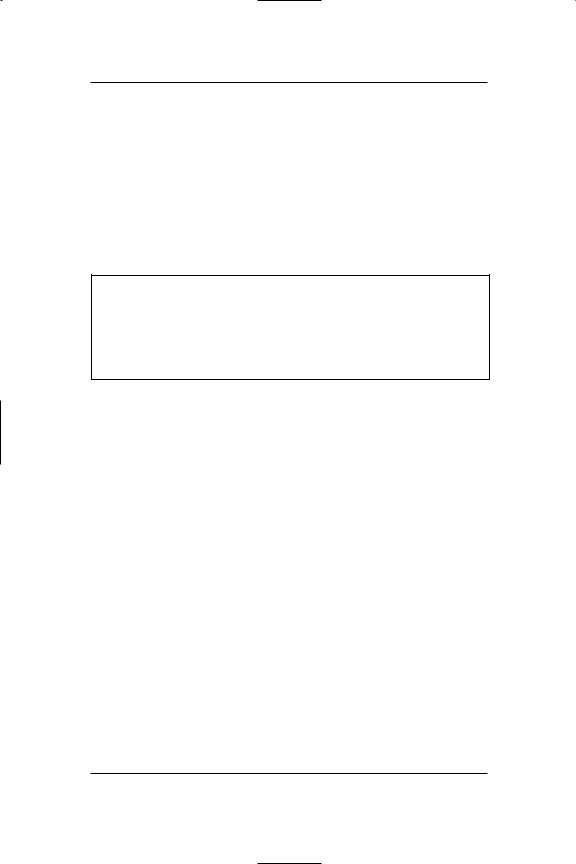
Allen J.G. - The Complete Q&A Job Interview Book (2004)(4th ed.)(en)
.pdf
Introduction

INTRODUCTION
A job interview is a screen test, an act. Getting hired depends almost completely on the actor factor. If you know your lines, perfect your delivery, and dress for the part, you’ll get hired. If you don’t, you won’t. No retakes. No bit parts.
For almost a decade, I was behind a personnel director’s desk, interviewing applicants of every age, stage, and wage, every day (and night—in my sleep). I’ve probably read every book on how to interview. I’ve taken courses on it. I’ve even trained supervisors on how to do it.
I rapped nonstop about interviewing techniques: directive or nondirective, specific or general, closed-ended or openended, structured or unstructured, restricted or unrestricted, window, choice, hypothetical, theoretical, interpretive, leading, loaded, stress, interrogation, machine-gun, multiple, double, curiosity, and so on.
Interviewing is a welcome break for supervisors and keeps a lot of personnellers off the unemployment line. But studying interviewing techniques is a total waste of time for a serious job seeker. At best, studying them will get you tired long before you’re hired. At worst, it will intimidate you. Interviewing hasn’t changed since Laurel hired Hardy. It’s just as comical as it has always been.
Now you can memorize the script in advance. There are only so many questions that can be asked and only so many ways to ask them. Oh, there might be minor variations—like the accent of the interviewer, his or her tone of voice, or a pause here and there. Experienced jobgetters appreciate them. Otherwise, they’d undoubtedly start snoring before the offers were extended.
Because interviews are so predictable, they’re controllable. Only the places and faces change—not the words. And
2

INTRODUCTION
you can have them all embedded in your subconscious, ready for instant replay at the drop of an interesting job lead.
I know—you think background, qualifications, or experience have something to do with getting hired. You’re right—not about the job, though. About interviewing! The director only knows what you show. That’s why the actor factor is so critical.
Twenty-five years ago, I developed the only measure that counts: the interview-to-offer ratio. If you ask enough people, you’ll find the ratio averages twelve to one: It takes twelve interviews for the average person to get one job offer. That means for every person who intuitively knows how to get hired every time (or uses our techniques), some walking wounded is limping into his or her twenty-fourth interview. For every two people who know, there’s someone being carried into his or her forty-eighth, showing battle scars and telling war stories. Destroyed, not employed.
After a while, these folks live with a self-fulfilling prophecy: rejection. They might as well just call the interviewer and say, “I’m canceling the interview. Your time is too valuable to waste with me.” They’re destined to flub their lines from the time the first board claps.
Tragic. Even more tragic when that interview-to-offer ratio will tumble down for anyone who’ll just follow the programmed interview system automatically. It’s nothing more than preparing that amazing computer between your ears to signal your mouth and limbs to move in the right way at the right time.
Unlike your conscious mind, which understands, judges, and controls (thinks), your subconscious mind stores information. If you give it the right input (images and cues), the output (words and actions) will be right, too.
3

INTRODUCTION
The input about interviewing that is now stored back there in your subconscious is probably based on a few random encounters when you were looking for a job. You were nervous, unprepared, and probably don’t even consciously remember how you reflexively responded. In fact, applicants forget 90 percent of the dialogue within hours after leaving an interviewer’s office! Some are lucky if they even remember their own names when they leave.
This is no way to learn how to respond to something so predictable as an interview. There’s no positive reinforce- ment—no disciplined practice, either. How unfortunate when your livelihood and personhood are on the line.
At first most people are afraid they’ll be like a bionic with a broken brain and will just talk or move out of context. Not a chance. The subconscious just stores. Words and actions will happen naturally when the time is right. You’ll adapt the delivery to your own vocabulary and mannerisms like any accomplished actor. That’s why interviewers will never know you’re using the system. They won’t care, either. They want that job requisition off their desks and out of their lives for as long as possible. They’ll even coach you if you know your lines.
Oh, maybe you have some moral problems with using the actor factor to your advantage and not being yourself. If so, I suggest you ask a past interviewer for the rating forms he or she used on you. It won’t get you hired, but it will open your eyes wide to the games interviewers play and to how biased, unfair, and incorrect their snap judgments really are. Now you can work this to your advantage.
People who interview well are better employees, too. That’s because they’ve learned how to interact on the job—to
4

INTRODUCTION
sell themselves and their ideas to others. They aren’t enslaved because they know they can always find another job. They’re working because they want to. They’re the ones who succeed in their careers: Positive interaction gets people hired, promoted, and recruited for better opportunities. They develop a loyal fan club, which follows them to the top.
All you’re doing is taking the most random selection process imaginable and controlling it. That’s right, you’re in control! No, I don’t recommend that you try to switch seats with the interviewer. You’ll never have that much control. It’s his or her office and decision (almost). After all, he or she can always yell, “Cut!”
So don’t fight it. Just do it. Let it work for you. Then you won’t want to fight it, anyway. You’ll feel great about yourself when you know you can knock any interview cold. You should. You have lifetime unemployment insurance and a supercharged career.
Here’s how to use the programmed interview technique to fast-forward your future:
1.Read the questions and answers to yourself once.
2.Customize the questions where necessary to apply to your background and target job.
3.Customize the answers where necessary to your vocabulary, background, and target job. (Just don’t change them radically; each answer is carefully designed and tested to score the most points. The further you deviate from it, the more you risk.)
4.Prepare a cassette for yourself containing the most difficult questions for you to answer, leaving spaces on the tape to
5

INTRODUCTION
read your answers aloud. (You can stop the tape occasionally to rehearse a particular response, but it is important to simulate an interview where the dialogue continues.)
5.Then, play the cassette at least three times a week for the next two weeks, sitting in front of a full-length mirror. Try to simulate an interview as closely as possible by using a table for a desk and adding other props. Don’t stop the tape. Pay attention to your facial expressions, hand movements, and body language. Smile. Look the interviewer (you) in the eye. Try not to speak with your hands. Lean forward to make a point.
6.Use your driving, riding, or walking time to listen to the cassette and answer the questions. (You can just think the answers, but talking aloud to your imaginary friend will rivet your attention. Engaging your mouth when your brain is in gear is good practice.)
PREPARATION
If you want to come out of a job interview with an offer on the table, then for you the interview should begin as far in advance of the date and time of your appointment as possible. For starters you’ll want to find out as much as you can prior to the big day about the company and the position you’re applying for. And you’ll need to find out what’s considered appropriate dress and deportment at the company. These issues are not as clear-cut as they once were. Traditionally, standards had been set, which no one questioned. Both men and women were expected to dress conservatively (suits and ties
6

INTRODUCTION
for men and business suits or dresses for women). As to personal conduct, the standard advice was to be reserved and respectful and let the interviewer control the interview.
Today abiding by these standards certainly will stand you in good stead in many situations and professions; when you’re in doubt, they can and should be considered your fallback position. But since the early 1980s, there is no single response to how to dress and behave in a job interview. In particular since the Internet has come into widespread use, with the concomitant explosion of e-commerce, job applicants may find themselves face to face with break-all-the-rules entrepreneurs as well as traditional business people—sometimes in the same day—who want and expect different things from job candidates. More than ever applicants must prepare themselves by researching the firms and people with positions to fill. Let’s begin by discussing the importance of learning all you can about the company you’ll be interviewing with.
It’s What You Know
Unless you know someone at the company where you’ll be interviewing, someone who can and is willing to share with you insider information, you have to reverse the adage “It’s not what you know, it’s who you know.” To be confident going into an interview (which is a primary ingredient in making a good impression), you need to find out as much as you can about the company—and ideally the person or people—you’ll be interviewing with. Fortunately, this has never been easier. Thanks to the Internet, and more specifically the World Wide Web, you can find out valuable information about most companies
7

INTRODUCTION
worldwide. No longer do you have to make difficult, sometimes embarrassing phone calls to receptionists or assistants and try to eke out any piece of information that might give you a leg up on the interview. No longer do you have to go to the library and track down articles in periodicals or newspapers in search of recent news on a company or person. Just log on to the Internet, and the business world is at your fingertips—literally.
Note If you don’t have Internet access from your home, most libraries and schools now provide free service to the public.
It’s How You Look
Since the 1980s, dress in the workplace has become almost universally more casual (with a few exceptions, such as the legal and investment brokerage professions); even doctors wear jeans or chinos under their lab coats (which aren’t even always white anymore). What started as casual Fridays have become casual all days in many organizations. Perhaps prompted by the rapid and widespread emergence of hightech companies, many of whose founding entrepreneurs considered themselves to be rebels against the tight-laced, suit-and-tie corporate world, the old rules of suits for men and dresses for women have, by and large, fallen by the wayside. Today most companies, large and small, have loosened their dress codes. To the job candidate, this raises difficult questions about how to dress for an interview. Do you dress the old-fashioned way, meant to show respect and to impress,
8

INTRODUCTION
or do you show your willingness to fit in by dressing as others in the company do? The answer is: It depends.
The following are some guideline questions to ask—and get answered—in advance of your scheduled interview.
How do the employees in your target company dress? Does there seem to be a standard, a dress code?
If you don’t know the answer to this, you might just want to conduct some on-site casual research (assuming you are not traveling out of town to the interview). Hang out during rush hour or lunch hour at the company headquarters, for example, to see how people are dressed. A more direct and surefire approach is to call the human resources department at the company and ask someone there what the dress code is. Do not be embarrassed to ask this question. It is the job of human resources personnel to act as the go-betweens for the employer and employee candidates. They want to ensure they’re not wasting the time of the interviewers by setting them up with inappropriate candidates, and they’ll respect your desire to dress correctly.
And don’t forget the Web; most companies now have web sites, and a good number of those sites include job opportunities sections or pages, where you might be able to get the information you need. In particular, if you’re interviewing with a large corporation, you’ll probably discover its web site goes into some detail about its recruitment procedures. Companies don’t want to waste their time or
9

INTRODUCTION
yours, so they make this information readily available. Take advantage of all the sources available to you.
What if the company is so small it has no human resources department or no web site?
Today, it’s highly unlikely that a company won’t have one of these sources of information available, but if this is the case, chances are you’ll have a preliminary screening interview, often by phone, either with the person you’ll be meeting with at a later date or with his or her assistant. During that conversation, you may be able to ask about the company’s dress code. If you feel it’s inappropriate or uncomfortable to do so, err on the side of caution: Dress conservatively, in traditional business attire—suits for men and business suits or dresses for women.
What if I’m told it’s okay to wear jeans?
Unless you’re absolutely sure this is acceptable, don’t do it. It’s still safer to dress “up”; in general no interviewer is going to penalize you for being too neatly or conservatively dressed. I say “in general” because today this, too, can be tricky. Some companies today, whose owners and executives prize creativeness and the entrepreneurial spirit, may be put off by someone who appears too traditional. Others are returning from casual to traditional. Again, preparedness is key: Know the industry, know the company. Probably a safe level of dress for this
10
